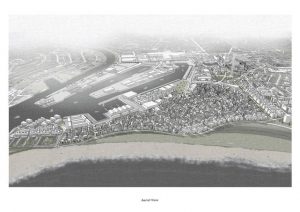PLANS for the creation of a new urban village in Aberdeen have been proposed by final year university architects.
The village, is proposed to be created between the harbour and esplanade, in the area between Castlegate and Footdee.
The plans hope to have services no more than 15 minutes away from every resident and the village will host a variety of eco friendly features with greenery at the heart of the plans.
The proposals are the result of a two year-project by students from The Scott Sutherland School of Architecture and Built Environment at Robert Gordon University.
The proposals are based on a new site becoming available due to the relocation of the new harbour in Nigg bay.
The existing old church of St Clements would become the focus for a new live, work and play community.
The concept is based on the idea of a ‘15 minute city’, meaning that everything you should need should be available within 15 minutes of walking.
The urban village would take a lead role in a developing a sustainable future and would encourage people to walk, cycle or use electric powered vehicles or, to use a public transport system, that would be electrically powered from renewable sources.
A shared community heating system would be created to power the new village, tapping into hot rocks under the city and using local expertise to create this natural, inexpensive geothermal energy.
Other green technologies such as solar, small scale wind and cutting edge piezoelectric generators could be used to capture energy from moving vehicles on roads.
The architects have said that greenery is at the heart of the village and people of all ages would be encouraged to enjoy a healthy lifestyle.
Security would also be built into the way each housing block overlooks each other in order to encourage a social living space.
The plans also outline a new beachfront for the city of Aberdeen and an opening up of the harbour front to people on the North edge.
The new proposals aim to make links from Castlegate to the beachfront and harbour more “feasible and pleasurable.”
The proposals are based on a new site becoming available due to the relocation of the new harbour in Nigg bay.
The existing old church of St Clements would become the focus for a new live, work and play community.
One student involved in the project, David Reid said: “During the pandemic I think a lot of people really reassessed their priorities when it comes to how they spend their time, especially those commuting, and where they spend it, parks and the countryside have never felt so valuable.
“These are key considerations we took with us during our design work on the project and feel this approach would be applicable across the city and country. “In the end I think it’s about putting people back at the heart of our cities.
“Our aim is to create a new urban village that is sustainable, affordable and accessible for everyone.
“We want to create a village that combines private living, flexible working spaces, easy to access amenities, and shared community areas.”
Course leader, Professor Neil Lamb said: “At a time when we have seen unprecedented change in city living, with some questioning the validity of living in cities in the post pandemic environment, the students set out to see what type of place could be made, learning from best national and international examples that people would want to live, work and play in.
“As humans, we long for meaningful relationships with those around us yet all too often infrastructure and the way we use our cities seems secondary in large re-developments.
“The new urban village of St.Clements, would re-establish village life at the heart of the city and create a model way of city living for years to come.
“It would be a place for all demographics; old and young, rich and poor to live in a new settlement that encourages citizenship and a real sense of community.”

